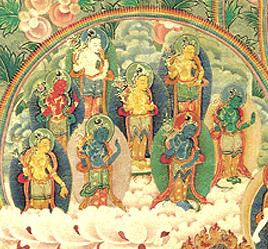Sangha: Difference between revisions
mNo edit summary |
mNo edit summary |
||
| Line 1: | Line 1: | ||
[[Image:Bodhisattva.JPG|frame|[[Bodhisattva]] sangha from the [[Longchen Nyingtik]] [[field of merit]]]] | [[Image:Bodhisattva.JPG|frame|[[Bodhisattva]] sangha from the [[Longchen Nyingtik]] [[field of merit]]]] | ||
'''Sangha''' (Skt. ''saṅgha''; Tib. ''gendün''; [[Wyl.]] ''dge 'dun'') is the term for the community of practitioners who are following the [[Buddha]]'s teachings. According to the [[Mahayana]] teachings, the sangha that is included within the [[Three Jewels]] as an object of [[refuge]] is the noble sangha, i.e., those who have reached the [[path of seeing]] and beyond. | '''Sangha''' (Skt. ''saṅgha''; Tib. [[དགེ་འདུན་]], ''gendün''; [[Wyl.]] ''dge 'dun'') is the term for the community of practitioners who are following the [[Buddha]]'s teachings. According to the [[Mahayana]] teachings, the sangha that is included within the [[Three Jewels]] as an object of [[refuge]] is the noble sangha, i.e., those who have reached the [[path of seeing]] and beyond. | ||
==Etymology== | ==Etymology== | ||
The Tibetan word for sangha is ''gendün'' (Wyl. ''dge 'dun''), which signifies those who aspire to or yearn for (''dün'') virtue (''gé''). Khenpo Ngakchung explains that virtue here refers to the [[Three higher trainings|threefold training]] in [[discipline]], [[meditation]] and [[wisdom]]. | The Tibetan word for sangha is དགེ་འདུན་, ''gendün'' (Wyl. ''dge 'dun''), which signifies those who aspire to or yearn for (འདུན་, ''dün'') virtue (དགེ་, ''gé''). Khenpo Ngakchung explains that virtue here refers to the [[Three higher trainings|threefold training]] in [[discipline]], [[meditation]] and [[wisdom]]. | ||
==Qualities== | ==Qualities== | ||
Revision as of 03:38, 3 February 2011

Sangha (Skt. saṅgha; Tib. དགེ་འདུན་, gendün; Wyl. dge 'dun) is the term for the community of practitioners who are following the Buddha's teachings. According to the Mahayana teachings, the sangha that is included within the Three Jewels as an object of refuge is the noble sangha, i.e., those who have reached the path of seeing and beyond.
Etymology
The Tibetan word for sangha is དགེ་འདུན་, gendün (Wyl. dge 'dun), which signifies those who aspire to or yearn for (འདུན་, dün) virtue (དགེ་, gé). Khenpo Ngakchung explains that virtue here refers to the threefold training in discipline, meditation and wisdom.
Qualities
Eight Qualities of the Sangha
According to Maitreya's Uttaratantra Shastra, the Sangha has 'eight qualities of knowledge and liberation' (Tib. རིག་གྲོལ་་གྱི་ཡོན་ཏན་བརྒྱད་, rig drol gyi yönten gye; Wyl. rig grol gyi yon tan brgyad):
Knowledge of:
- 1) the profound nature of phenomena
- 2) the vast – phenomena in all their multiplicity
- 3) discriminating awareness wisdom
Liberation of:
- 4) attachment, the emotional obscurations
- 5) hindrance, the cognitive obscurations
- 6) the inferior – the obscurations of the shravakas and pratyekabuddhas
And
- 7) knowledge; and
- 8) liberation.
Teachings Given to the Rigpa Sangha
- Dzongsar Khyentse Rinpoche, Berlin Centre, 26 June 2010
Further Reading
- Khenpo Ngawang Palzang, A Guide to the Words of My Perfect Teacher, Shambhala, 2004, pages 108-123.